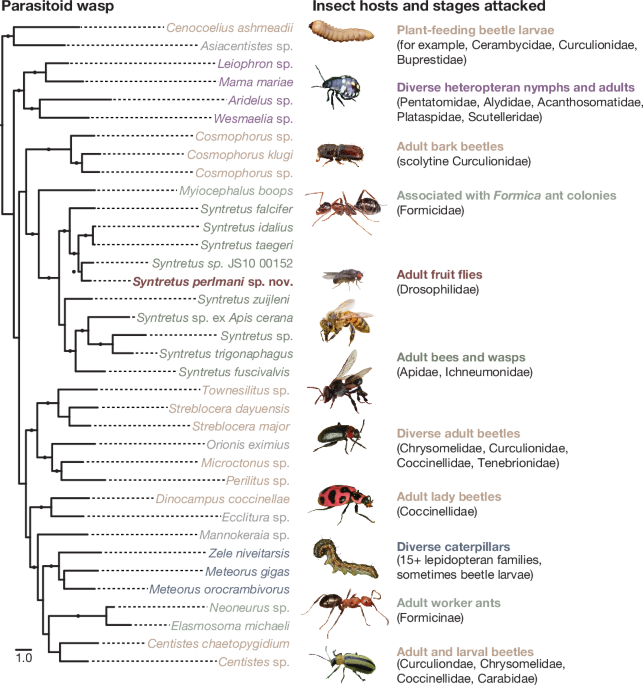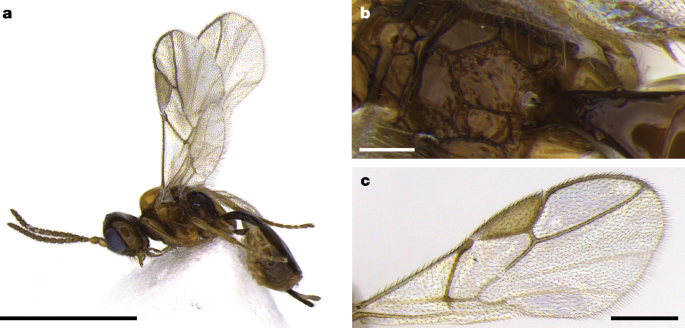Family Braconidae Latrielle, 1829
Subfamily Euphorinae Foerster, 1862
Tribe Syntretini Shaw, 1985
Genus Syntretus Foerster, 1862
Subgenus Syntretus Foerster, 1862
Syntretus perlmani sp. nov. Shaw & Ballinger, 2024
Etymology. This species is named after SteveâPerlman (University of Victoria, British Columbia, Canada), in recognition of his contributions to research and mentorship in the field of Drosophilaâparasite interactions.
Type material. Holotype: female (deposited in the University of Wyoming Insect Museum, UWIM), USA, Mississippi, Oktibbeha County, Starkville; Global Positioning System (GPS): 33.494303, â88.753891; locality: residence backyard, pine and cedar forest; L.D.M. collector; reared from infected host adult male D.âaffinis; collection date of infected fly: 12 July 2023; parasitoid larval emergence date: 21 July 2023; adult wasp emergence date, 13 August 2023; date of death: 24 August 2023; tube label: Buttercup.
Paratype. One female, same data as holotype except collection date of infected fly: 5 April 2023; (parasitoid) larval emergence date: 15 April 2023; adult (wasp) emergence date: 7 May 2023; date of death: 12 June 2023; tube label: Dorothy (UWIM). One female, same data as holotype except collection date of infected fly: 28 May 2023; (parasitoid) larval emergence date: 9 June 2023; adult (wasp) emergence date: 3 July 2023; date of death: 8 July 2023; tube label: Betsy Bobbin (UWIM). One female, same data as holotype except collection date of infected fly: 13 July 2023; (parasitoid) larval emergence date: 24 July 2023; adult (wasp) emergence date: 18 August 2023; date of death: 22 August 2023; tube label: Leeloo (UWIM). One female, same data as holotype except collection date of infected fly: 14 July 2023; (parasitoid) larval emergence date: 23 July 2023; adult (wasp) emergence date: 16 August 2023; date of death: 4 September 2023; tube label: Barbie (UWIM). One male, same data as holotype except collection date of infected fly: 13 June 2023; (parasitoid) larval emergence date: 22 June 2023; adult (wasp) emergence date: 16 July 2023; date of death: 25 July 2023; tube label: Javier Bardem (UWIM). One male, same data as holotype except collection date of infected fly: 14 July 2023; (parasitoid) larval emergence date: 24 July 2023; adult (wasp) emergence date: 16 August 2023; date of death: 29 August 2023 (preserved alive); tube label: Keith (UWIM). One female, North Carolina, Wake County, Apex; GPS: 35.741349, â78.834234, locality: watermelon bait in residential neighbourhood; M.J.B. collector; reared from infected host adult male D.âaffinis, collection date of infected fly: 13 June 2023; (parasitoid) larval emergence date: 22 June 2023; adult (wasp) emergence date: 18 July 2023; date of death: 29 July 2023; tube label: Alice (UWIM). One male, same data as preceding female except no collection data; laboratory-reared from mother (Alice); host: female adult D.âaffinis; oviposition date: 21 July 2023; adult (wasp) emergence date: 29 July 2023; date of death: 6 September 2023 (preserved alive); note: 13 flagellomeres; tube label: Male offspring of Alice (UWIM).
Description of the holotype. Female, length of forewing 1.98âmm, length of body 1.45âmm.
The details of the head are as follows. Antenna with 14 antennomeres (scape, pedicel and 12 flagellomeres), flagellomeres moderately bristly setose (Fig. 4a and Extended Data Fig. 6c; antennomere measurements and ratios in the Supplementary Discussion); mandible long and slender, 3.3 times as long as basal width; length of maxillary palpus (248.1âµm) 0.7 times height of head (348.5âµm); face smooth and shining, moderately setose, with setae arising from distinct punctures (Extended Data Fig. 6c,d); face shape roughly isosceles trapezoidal, narrowest above, where eyes converge most closely, widest along lower margin near clypeus; face greatest width 2.2 times wider than face height medially; clypeus smooth (except setae and scattered punctures), slightly convex, lower clypeal margin even with lower level of eyes; clypeal setae long, especially ventrally, longest setae more than 2 times as long as facial setae (Fig. 4a; Extended Data Fig. 6c); frons smooth and moderately setose laterally, more glabrous medially, and without a median groove or carina, rather flat in front of anterior ocellus; gena, temple and vertex mostly smooth and shining (especially as compared to frons and face), only a few scattered small setae ventrally on gena; ocelli small, lateral ocellus width just slightly greater than basal flagellomere (F1) width; eye shape ovoid, narrowest dorsally, broader ventrally, slightly protruding anteriorly but not extending beyond face; eye in lateral view 1.6 times taller than greatest width; greatest eye width 1.1 times gena width; temples parallel-sided behind eyes; length of malar equal to basal width of mandible; occipital carina well-developed laterally, weak dorso-medially; hypostomal carina not visible.
The mesosoma is shown in Fig. 4a,b. Antescutal depression narrow; mesoscutum smooth (including notaulic area anteriorly), glabrous; notauli absent; scutellar disc slightly convex, entirely smooth and glabrous (devoid of setae); scutellar sulcus with three cross-carinae delimiting two large submedial foveae; metapleuron mostly smooth, except weakly rugulose basally; propodeum anteriorly with a short median carina (about equal in length to median carina of scutellar sulcus), posteriorly gradually declivous and with a large pentagonal areola, laterally with rugosity and costulae; propodeal spiracle circular, slightly broader than width of carinae delimiting pentagonal areola (Fig. 4b).
The forewing is shown in Fig. 4c. Pterostigma 2.9 times longer than wide; vein r short, emerging from pterostigma distinctly beyond middle; vein 1-R1 1.14 times longer than pterostigma length; vein RS long, only slightly curved, ending near apex of wing, 1.43 times longer than pterostigma length, and 9.88 times longer than vein r length; marginal cell maximum length times longer than maximum width; cross-vein 1âcu-a nearly even with base of vein 1-M; wing membrane moderately densely and evenly setose over the entire wing, basal and subbasal cells as densely setose as other cells.
The details of the hindwing are as follows. Vein 1-SCâ+âR is tubular and sclerotized; vein 1r-m not separated from vein 2-SCâ+âR (Extended Data Fig. 6a,b).
The legs are shown in Fig. 4a and Extended Data Fig. 6a). Hind femur 4.38 times longer than maximum width; hind tibia 11.25 times longer than maximum width; hind basitarsus 6.0 times longer than maximum width; fore femur 3.33 times longer than maximum width; tarsi with short setosity ventrally; tarsal claws small, slender and strongly curved.
The details of the metasoma are as follows. First tergite (T1) narrow and slender basally, gradually wider posteriorly, basal width 0.2 times length of T1, apical width 0.65 times T1 length; first tergite smooth basally and apically, medially with faint rugulose sculpture, laterally with margin weakly carinate, giving the appearance of a distinct edge separating the dorsal surface of T1 and its lateral sides (Fig. 4a); laterope absent (Fig. 4a); ovipositor sheath long and slender, slightly widened apically, slightly narrower medially, and with scattered long setae over entire length (Fig. 4a), visible portion of ovipositor sheath 11.6 times longer than median width (see details on variation below); ovipositor (in holotype) not visible except tip, appearing straight.
The colour is shown in (Fig. 4a,b and Extended Data Fig. 6). Yellowish brown; antenna (except for two basal segments) dark brown; first tergite, apical half of metasoma dorsally and ovipositor sheath darkened; apical half of hind tibia and tarsus slightly darker than remainder of legs; palpi, tegulae, coxae, trochanters, second and anterior half of third metasomal segment whitish; veins yellowish brown, but veins Câ+âSCâ+âR, and r of forewing and pterostigma brown; wing membrane subhyaline; both valves of ovipositor brown, but upper valve slightly darker.
Details of variation are as follows. Antenna with 12 or 13 flagellomeres. On the basis of other material reared in Mississippi (not included in the type series), it seems that flagellomere number may be correlated with the size and sex of the host fly (Extended Data Fig. 4). Wasps that develop in male host flies are slightly smaller, and wasps reared from these have 12 flagellomeres (most of the type series show this character state). Wasps that develop from female host flies are slightly larger, and the resulting wasps have 13 flagellomeres.
The appearance of the ovipositor varies depending on the degree to which it is exserted at the time the specimen is preserved. In the holotype the ovipositor is in its resting position, appearing straight, partly drawn inside the body, resting within the ovipositor sheaths, with the ovipositor tip just barely visible. In other specimens, the ovipositor is extended farther out of the body, appears thicker basally, thinner apically, and is slightly curved. In specimens with the ovipositor extended, the hypopygium (last sternite) is bent ventrally, and the ovipositor sheathes are folded dorsally, being partly concealed basally by the apex of the metasoma but extending dorsally well above the metasoma dorsum. In specimens with the ovipositor fully visible and extended, the ovipositor is clearly much longer than the hind tibia length.
Distribution. USA, Mississippi and North Carolina. Collected in MayâAugust. However, screenings of global DNA datasets performed in this study suggest a broader distribution across the eastern USA.
Differential diagnosis. Syntretus perlmani sp. nov is a tiny species that is distinct from other known Syntretus species by virtue of its small size (body length about 1.5âmm) and utilization of adult Drosophila flies as hosts. The antenna is shorter than the head and mesosoma combined, and there are 12â13 flagellomeres. Often the antenna has only 12 flagellomeres (the lowest number recorded for any North American Syntretus species).
Of the North American species, S.âperlmani is most similar to Syntretus brevicornis Muesebeck, which also has a small body size and short antenna. Of the two species, S.âperlmani is the smaller, with a body length of about 1.5âmm, as compared to 2.2âmm for S. brevicornis. As far as we are aware, S.âperlmani has the smallest body length of any known Syntretus species, worldwide. The hind femur of S.âperlmani is longer and narrower than in S.âbrevicornis (hind femur about 4.4 times longer than wide in S.âperlmani, as compared with 4.0 times longer than wide in S.âbrevicornis). The ovipositor is longer in S.âperlmani with the ovipositor being as long as the hind tibia and basal three hind tarsomeres combined, whereas the ovipositor is about equal to the hind tibia length in S.âbrevicornis. The colour patterns of the two species are distinctly different, especially that of females. In the holotype of S. perlmani the pronotum laterally is dark brown contrasting with the mesonotum, which is yellow or light yellowish brown. In the holotype of S.âbrevicornis this pattern is reversed, with the pronotum laterally being light yellowish brown and the mesonotum being dark brown. For additional taxonomic details, see the Supplementary Discussion.



